Apollo 11 astronaut and MIT alumnus Buzz Aldrin (PhD 1963) returned to MIT on June 16 to speak about his experience in space exploration and to describe his new book, The Return.
He and fellow astronaut Neil Armstrong became the first humans to explore the lunar surface on July 20, 1969.
Dr. Aldrin talked about his early interest in aviation and his exposure to legendary aviators including Jimmy Doolittle and Billy Mitchell. He noted that Winston Markey, a high school classmate and now a professor in MIT's Department of Aeronautics and Astronautics, wrote under Dr. Aldrin's 1947 high school yearbook photo, "Moon rockets&emdash;I'll build them, you fly them."
Dr. Aldrin, whose doctoral thesis work was on manned orbital rendezvous, was selected as a NASA astronaut in 1963 after completing his thesis in aeronautics and astronautics. On his first space flight on Gemini 12 in 1966, he completed three space walks, participated in three space rendezvous maneuvers and conducted a gravity gradient tether demonstration.
Describing his experience of walking on the moon, Dr. Aldrin said, "I've been asked those questions many times and I wish I had an emotion recorder... it's hard to remember those emotions... there was the pressure of looking good, of doing something for the first time, and you sure didn't want to make a mistake.
"The two of us were on the moon, and it just occurred to me that what an odd situation, that two guys are further away from home than anyone's ever been, not just in distance but in what we have to do, and more people were watching what we were doing" than at any other time in human history, Dr. Aldrin said.
"Millions of people were influenced by that event, their lives were affected in a positive way, and those who were around then want to tell me where they were," he said. "And that is the value of a human endeavor of that nature."
When asked whether he was disappointed about progress in space in the 30 years since Apollo 11 landed on the moon, he said, "Of course we all felt it would have sustained itself more... but let's not blame the leadership too much, because they had to respond to the public, and the American people were just not supportive."
Dr. Aldrin criticized the choice of solid rocket boosters in development of the space shuttle. "After the Challenger accident, we should have taken some steps to come up with a replacement," he said.
John Glenn's recent return to space aboard the shuttle was a great thing for public enthusiasm about the space program, he said. "When ordinary people start to fly into space, there will be a lot of attention paid to that. It's the involvement of people doing this that will make the difference."
Dr. Aldrin was enthusiastic about space tourism and the prospects for developing low-cost, reliable and reusable launch vehicles. "If we can make [space tourism] happen, it will change the whole complexion of space transportation." He also described his Star Booster concept, which uses an Atlas III booster core for increased reliability. "Reusability is the way you're going to make these things more reliable and cheaper," he said.
Dr. Aldrin said he was thrilled to be back at MIT. "To know the history of this place and to be able to come back here and to write something that might be of interest to you... what a neat thing that is."
After the lecture, he signed copies of The Return, an adventure story about a tragic space shuttle accident, international intrigue and the rescue of a stranded crew from the International Space Station. The Lecture Series Committee and the MIT Coop sponsored the event.
A version of this article appeared in MIT Tech Talk on July 12, 2000.






